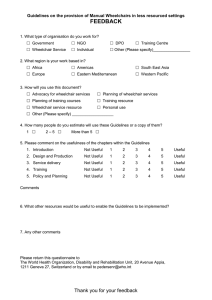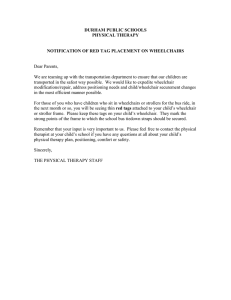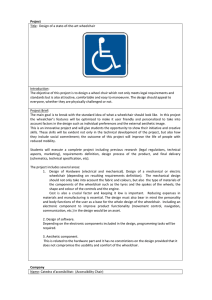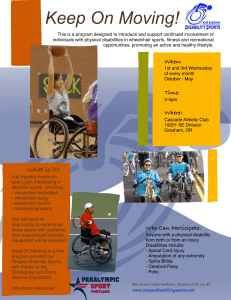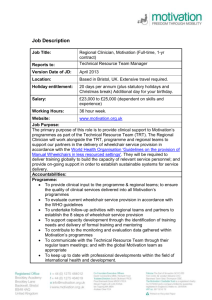Chapter 3
advertisement
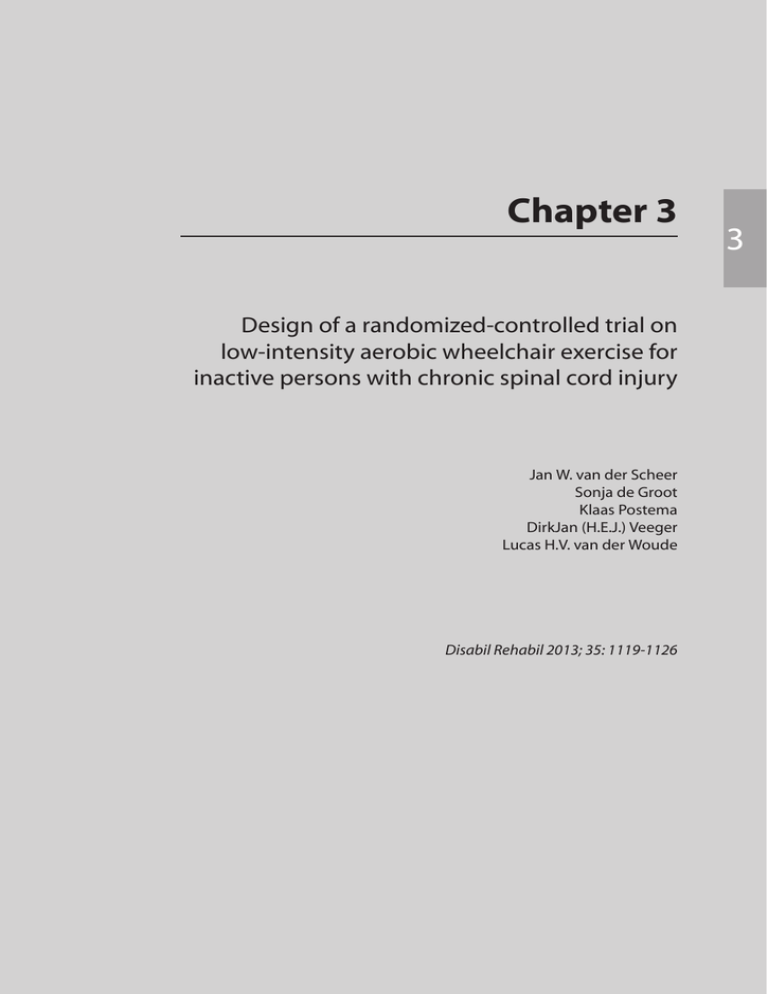
Chapter 3 Design of a randomized-controlled trial on low-intensity aerobic wheelchair exercise for inactive persons with chronic spinal cord injury Jan W. van der Scheer Sonja de Groot Klaas Postema DirkJan (H.E.J.) Veeger Lucas H.V. van der Woude Disabil Rehabil 2013; 35: 1119-1126 3 Chapter 3 wheelchair users (aged 28-65y) with chronic paraplegia or tetraplegia (time since - 40 Design of the RCT 1 2 3 1 As a 9 9 10 12 13 prescribing moderate to vigorous aerobic intensities 15 Table 1. College of Sports Medicine.16 Measure of intensity Relative intensity - 17-19 17 41 3 1 Chapter 3 19 16 - 22 23 Although - 25 Figure 1. Wheelchair skill performance and physical activity levels a 42 Design of the RCT 26 27 - 29 2 Another mechanism leading to improved propulsion technique during low-inten- 30 31 - » » levels); » lead to an optimized propulsion technique; and » 32 43 3 1 Chapter 3 Participants - Table 2. Inclusion criteria Aged 28-65 years Exclusion criteria Cardiovascular contra-indications for testing according to the ACSM guidelines33 cate performance of wheelchair propulsion 34 44 Design of the RCT Design All exercise tests and training sessions will be conducted within the two rehabili- Measurement Week T1 T2 T3 T4 0 8 16 42 Exercise group Control group Low-intensity wheelchair training No intervention provided No intervention provided Figure 2. Randomization - Table 3. Group size and allocation ratio of the two rehabilitation centers. RC 1 RC 2 3:2 1:2 5 or 10 3 or 6 N 25 15 N 15 5 N 10 10 45 3 1 Chapter 3 Table 4. Exercise (min) Exercise + rest (min) Exercise blocks (N) Rest between exercise blocks (min) 18 23 6 1 18 28 6 2 18 28 6 2 24 29 6 1 24 34 6 2 24 38 8 2 30 31-35 2-6 1 30 33-40 4-6 1-1.5 30 39-48 10 1-1.5 30 30 1 0 30 33 4 1 30 39 10 1 Week 1 Week 2 Week 3-7 Week 8-16 A 16-week low-intensity aerobic wheelchair exercise program will be employed; participants conduct two 30-minute sessions per week on a motor-driven treadmill (center In some persons 37 38 21 -1 46 and can be lower depending Design of the RCT - 3 1 - 38 Outcomes - - 47 48 Lesion level Demographics and environmental Supplementary outcomes Wheelchair skill performance Shoulder load Upper-body discomfort Upper-body pain Secondary outcomes 44 ASIA assessment Mechanical wheelchair odometer48 Wheelchair Circuit 35 46 42 Questionnaire on musculoskeletal upper-body pain8 45 28,47 34 X X X X Xb Xb X X X X Xb Xb X X X X X X X X a X X X X X X X T3 a X X X X Isometric wheelchair push X X Isometric strength 43 15m overground wheelchair sprint X X Anaerobic work capacity X X 35 35 X X 35 35 T2 T1 Instrumentation Outcome measure Table 5. Xb Xb X X X X X X X X X X T4 Chapter 3 satisfaction c b a and sitting 53 21 Forced spirometry measurements 49 51 57 54 2 5 50 55 56 Xb X c X X X X X X X X X X X X X X X X X Systematic assessment, by researcher and paramedic research assistant, whether there are changes relative to the T1 measurement. Not performed in order to reduce participant burden. Independence Quality of life Mood Fatigue Metabolic health Wheelchair comfort Goniometer-measured angles of shoulder, elbow and wrist joints X X X X X X X X X Xb X X X X X X X X X Xb Design of the RCT 3 1 49 Chapter 3 Peak and submaximal wheelchair exercise test 35 - -1 58 35 15m overground wheelchair sprint Anaerobic work capacity will be based on PO during a 15m overground wheelchair 35 - Isometric wheelchair push It can be seen as an isometric wheelchair push with - 50 Design of the RCT 3 1 Figure 3. Set-up of the isometric wheelchair push used to assess isometric strength. See chapter 5 for a schematic presentation of the set-up. Self-report questionnaires on upper-body pain 8 60 shown - Local Perceived Discomfort (LPD) scale similar to a protocol used to study handcycling in able-bodied 61 61 It 51 Chapter 3 Propulsion technique 28 2 Delft Shoulder and Elbow model 12 12 Wheelchair Circuit 35 Physical Activity Scale for Individuals With Physical Disabilities (PASIPD) Wheelchair odometer Statistical analysis and was based on two intervention studies: low-intensity aerobic wheelchair exercise in able-bodied persons and handcycle exercise in persons with tet62 52 Design of the RCT 3 1 62 - - 53 Chapter 3 - - - - - 54 Design of the RCT - - - 55 3 1 Chapter 3 - 56 Design of the RCT 3 1 57
